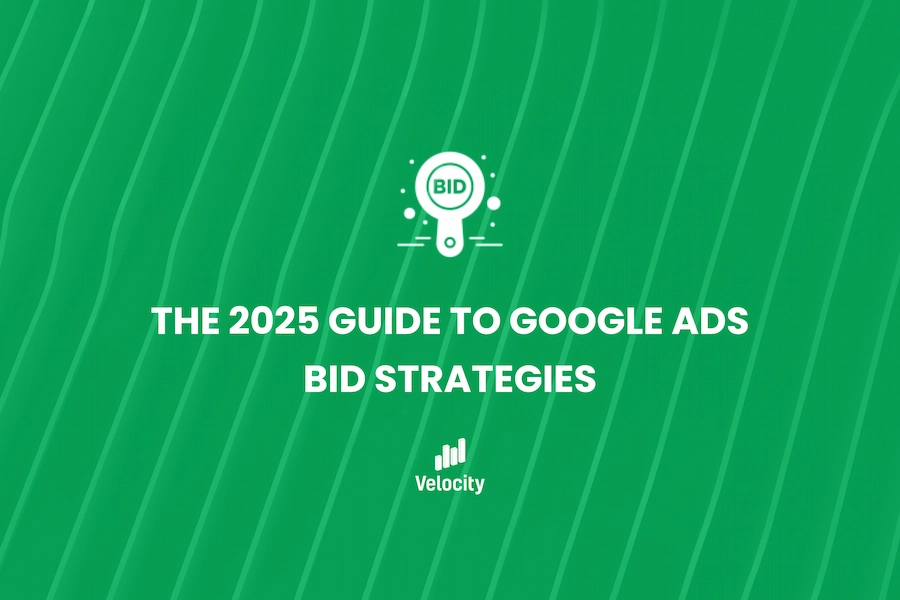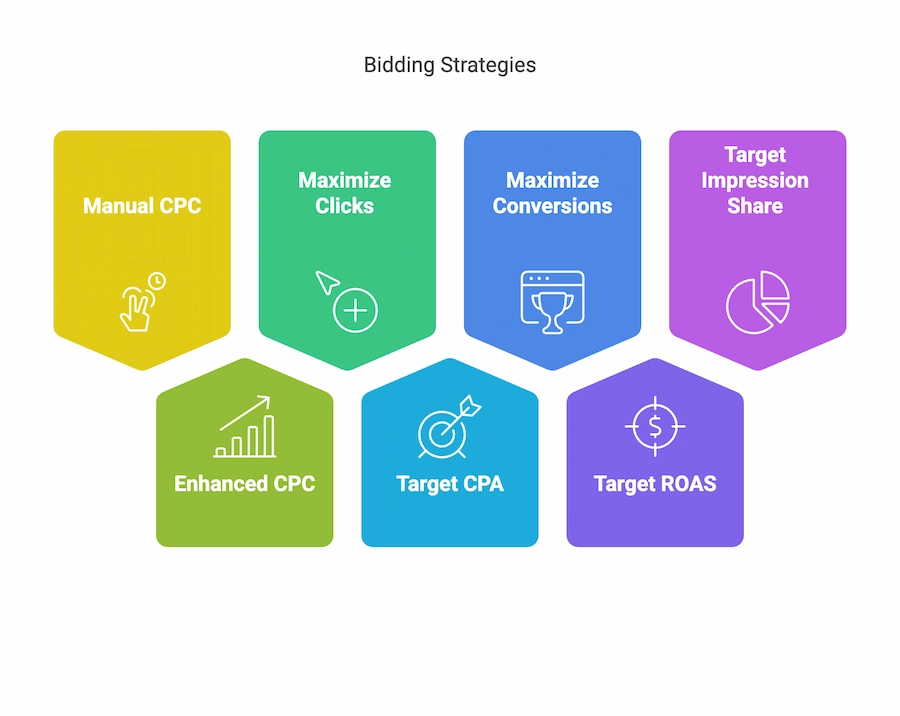The 2025 Guide to Google Ads Bid Strategies

When it comes to running successful Google Ads campaigns, having the right bidding strategy is just as important as choosing the right keywords, audience, and ad creatives.
Whether you’re looking to maximize conversions, control costs, or dominate the search results, the right bid strategies for Google Ads can make or break your campaign.
But with so many Google Ads bidding strategies available, how do you know which one is best for your business?
In this guide, we’ll break down the different types of Google Ads bid strategies, their pros and cons, and how to optimize your bidding to maximize your ROI in 2025.
Understanding Google Ads Bid Strategies
What Is a Bidding Strategy in Google Ads?
In Google Ads, a bid strategy determines how much you’re willing to pay when a user clicks on your ad or takes a specific action. Google’s system automatically competes in the ad auction on your behalf, depending on the bidding method you choose.
Types of Bid Strategies in Google Ads
Google Ads offers two main categories of bidding strategies:
- Manual Bidding – You set your own bids and adjust them as needed.
- Automated Bidding – Google adjusts bids automatically to optimize performance.
Both have their advantages and drawbacks, which we’ll explore below.
Best Bidding Strategies for Google Ads & When to use Them

1. Manual CPC (Cost-Per-Click) – Best for Control Freaks
How It Works:
- You set your max CPC bid for each keyword.
- You can increase or decrease bids manually based on performance.
Pros:
- Full control over how much you bid per click
- Avoid overpaying for low-performing keywords
- Great for experienced, hands-on PPC managers
Cons:
- Time-consuming and requires constant monitoring
- No AI optimization
Best For:
- Advertisers who want full control over bids
- Campaigns with limited budgets that need strict cost control
2. Enhanced CPC (ECPC) – Best for a Hybrid Approach
How It Works:
- You set manual bids, but Google adjusts them slightly to increase conversions.
- Google raises bids when a user is more likely to convert.
Pros:
- Offers some automation while maintaining manual control
- Helps optimize conversions
Cons:
- Still requires manual monitoring
- No full AI automation
Best For:
- Advertisers who trust AI but want control
- Conservative marketing campaigns where scaling isn’t a priority
3. Maximize Clicks – Best for Driving Traffic
How It Works:
- Google automatically sets bids to get the most clicks within your budget.
- Works great for campaigns focused on brand awareness or website visits.
Pros:
- Great for high-traffic campaigns
- Fully automated
Cons:
- May bring low-quality clicks that don’t convert
- No focus on conversion value
Best For:
- Websites that need more traffic
- Brand awareness campaigns
4. Target CPA (Cost-Per-Acquisition) – Best for Cost-Efficient Conversions
How It Works:
- Google adjusts bids to get conversions at your target CPA.
- E.g. If you set a CPA of $10, Google aims to get conversions at or below $10.
Pros:
- Helps maintain a fixed cost per lead
- Saves time with AI-driven optimization
Cons:
- Requires historical conversion data to work well (around 30 conversions per month is a good starting point)
- May limit ad visibility if CPA is set too low
Best For:
- Lead generation campaigns
- B2B Google Ads management
5. Maximize Conversions – Best for Fast Growth
How It Works:
- Google sets bids to get the most conversions possible within your budget.
- AI makes adjustments in real time to prioritize conversions.
Pros:
- Ideal for businesses looking to scale quickly
- Uses AI to optimize performance
Cons:
- Can lead to higher CPCs if not monitored
- Requires conversion tracking to function effectively
Best For:
- Advertisers with aggressive growth targets
- Businesses with flexible budgets
6. Target ROAS (Return on Ad Spend) – Best for Ecommerce Advertisers to Maximize Revenue
How It Works:
- Google sets bids to achieve a specific ROAS goal.
- If you set a ROAS goal of 500%, Google aims to return $5 for every $1 spent.
Pros:
- Perfect for profit-driven, ecommerce campaigns
- Prioritizes high-value conversions
Cons:
- Requires strong historical data
- Can limit ad reach if ROAS is set too high
Best For:
- Ecommerce businesses
- High-margin products or services
7. Target Impression Share – Best for Dominating the SERPs
How It Works:
- Google adjusts bids to get your ads seen more often.
- You can set where your ad appears (top of page, absolute top, or anywhere).
Pros:
- Ideal for brand visibility
- Helps you outbid competitors
Cons:
- Not focused on conversions or ROI
- Can lead to higher ad costs
Best For:
- Industry-specific Google Ads campaigns
- Brand awareness goals
Choosing the Best Google Ads Bidding Strategy for Your Goals
| Goal | Best Bidding Strategy |
|---|---|
| Brand Awareness | Target Impression Share, Maximize Clicks |
| Traffic Growth | Maximize Clicks |
| Lead Generation | Target CPA, Maximize Conversions |
| Ecommerce Sales | Target ROAS, Maximize Conversions |
| Budget Control | Manual CPC, Enhanced CPC |
| High Competition | Target Impression Share, Target ROAS |
Best Practices for Google Ads Bidding Strategies
1. Start with CPC-Focused Strategies Before Optimizing for Conversions
If you’re new to Google Ads, start with Manual CPC or Maximize Clicks with a CPC cap to get an idea of costs and performance.
2. Use Smart Bidding with Caution
Google’s automated bidding is powerful but needs historical data to work effectively. Aim for around 30 conversions per month before testing these bid strategies.
3. Continuously Optimize Your Bidding Strategy
No single strategy is set and forget—always analyze and adjust.
4. A/B Test Different Strategies
Run small test campaigns with different bidding strategies to compare performance. Google ads experiments can help you split test with confidence.
5. Monitor Key Google Ads Metrics
Track CTR, conversion rates, CPC, and ROAS to make informed bidding adjustments.
Final Thoughts
Finding the right bid strategy in Google Ads requires strategy, testing, and ongoing optimization. Whether you’re focused on lead generation, ecommerce sales, or brand awareness, the right bid strategy is crucial. You’ll likely use a mix of different bid strategies across your campaigns, depending on your ad objective, and what stage of the funnel you’re focusing on.
Want expert help optimizing your Google Ads bidding strategy? Work with a Google Ads agency like Velocity to maximize ad ROI and scale your campaigns effectively.
Get in touch today, we’d love to chat.
